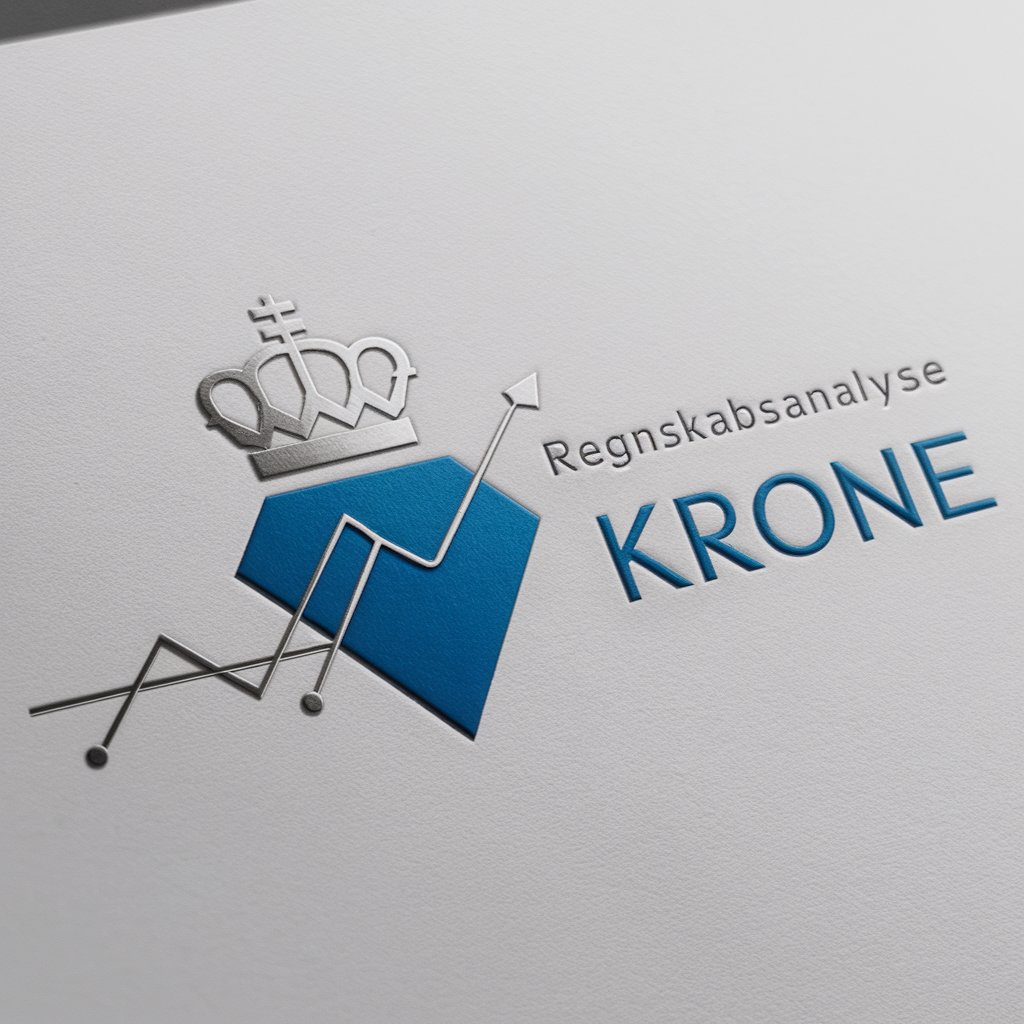Regnskabsanalyse Krone - AI-powered financial analysis

Welcome! Let's dive into your financial analysis needs.
Transforming data into financial clarity.
Explain the importance of liquidity ratios in financial analysis.
Describe the impact of solid equity on a company's financial health.
Analyze the key differences between short-term and long-term liabilities.
Discuss the role of thorough auditing in ensuring accurate financial statements.
Get Embed Code
Introduction to Regnskabsanalyse Krone
Regnskabsanalyse Krone is designed as an expert tool for financial analysis, specifically tailored to evaluate and analyze financial reports from Danish companies. It has been developed to provide in-depth financial analysis, focusing on key aspects such as audit checks, earnings evaluation, liquidity ratios, solidity assessment, and other critical financial metrics. Its purpose is to help users interpret financial data effectively, aiding in decision-making processes related to investments, risk assessment, and financial planning. For example, it can assess whether a company's liquidity ratio is above 100%, a benchmark for satisfactory performance, or evaluate a company’s solidity by determining if its equity ratio falls within the healthy range of 30% to 40%. Powered by ChatGPT-4o。

Main Functions of Regnskabsanalyse Krone
Audit Checks
Example
Determining if the company's financial statements have been reviewed by an independent auditor, which helps assess the reliability of the financial information presented.
Scenario
A user analyzing BE Venture ApS's annual report wants to ensure the financial statements are trustworthy. Regnskabsanalyse Krone can highlight that Grant Thorton has reviewed the accounts, providing a level of assurance.
Earnings Evaluation
Example
Analyzing key profitability indicators such as 'Resultat før skat' (Profit before tax) and 'Årets resultat' (Annual results), and comparing them over different periods.
Scenario
Evaluating Weber Jensen Trading ApS’s financial performance by analyzing its modest annual results and understanding the impact of increasing gross profit offset by higher salary costs.
Liquidity Assessment
Example
Calculating and interpreting the liquidity ratio to evaluate a company's ability to cover short-term obligations with its most liquid assets.
Scenario
Assessing Dansk Transportservice ApS’s liquidity by calculating its liquidity ratio and concluding whether the company can meet its short-term liabilities effectively.
Solidity and Solvency Analysis
Example
Examining the company's equity capital in relation to its total assets to gauge financial stability and long-term solvency.
Scenario
Analyzing Lyngfeldt A/S’s high equity ratio and discussing how distributing all profits as dividends affects the company's financial solidity.
Risk Classification
Example
Categorizing companies into different risk categories based on their financial health and potential risks.
Scenario
Determining the risk classification for New Balance Denmark ApS based on its solid profit before tax, satisfactory liquidity, but poor equity ratio.
Ideal Users of Regnskabsanalyse Krone
Financial Analysts
Professionals who require detailed analyses of company financials to make informed investment decisions or provide advice to clients. They benefit from the comprehensive breakdown of financial health indicators and risk classifications.
Business Managers and Owners
Individuals in management positions within companies who need to understand their own or competitors' financial standings. They use the tool to benchmark performance and strategize for future growth.
Credit Analysts and Lenders
Banking and financial service professionals who assess the creditworthiness of businesses applying for loans. They benefit from the tool's risk classification and financial health assessment features.
Academic Researchers
Researchers and students focusing on finance, who utilize the tool for academic purposes, such as case studies or industry analysis. They benefit from the structured approach to financial analysis.

How to Use Regnskabsanalyse Krone
1
Begin by visiting yeschat.ai for an instant trial that requires no sign-up or ChatGPT Plus subscription.
2
Upload your financial reports in PDF format. Ensure you have the latest annual report and the most recent financial statements ready.
3
Specify the analysis criteria or aspects you're interested in, such as profitability, liquidity, or asset management.
4
Submit your request for analysis. Provide any additional information or specific questions you want the analysis to address.
5
Receive your detailed financial analysis report. Review the insights, recommendations, and risk classifications provided to inform your decision-making.
Try other advanced and practical GPTs
Meditate Mate: Beginner's Journey to Mindfulness
Elevate mindfulness with AI-powered guidance

Manual Oracle
AI-Powered User Manual Expertise

Manual Master
AI-Powered Documentation Mastery

Manual Maker
Craft, collaborate, and publish manuals effortlessly.

Manual Maker
AI-powered document transformation

MicrobiomeExpert
Unlocking the Secrets of Your Microbiome

Soul Scribe
Insights at Your Fingertips
Crisp Agile Advisor
Empower Agility with AI

Prompt Generator
AI-powered tool for creating concise prompts and descriptions

Quiver
Empowering Transparency in Congressional Investing

Baldur's Gate 3 Class Synergy Guide
Optimize Your Adventure with AI-Powered Class Synergies

Heroclix Strategist
Strategize, Compete, Conquer - AI-Powered

Frequently Asked Questions about Regnskabsanalyse Krone
What types of financial reports can Regnskabsanalyse Krone analyze?
Regnskabsanalyse Krone can analyze a wide range of financial reports, including annual reports, quarterly reports, and specific financial statements, provided they are in PDF format.
How detailed is the financial analysis provided by Regnskabsanalyse Krone?
The analysis is comprehensive, covering aspects such as earnings, liquidity ratios, solidity, assets and liabilities, and risk classification, with a focus on the company's financial health and potential risks.
Can Regnskabsanalyse Krone handle reports in languages other than Danish?
Primarily designed for reports in Danish, Regnskabsanalyse Krone's effectiveness may vary with reports in other languages. It's best to consult for multilingual support.
Is there any sector or industry that Regnskabsanalyse Krone specializes in?
While Regnskabsanalyse Krone is versatile and capable of analyzing financial reports from various sectors, its accuracy and insights might be particularly beneficial for SMEs, startups, and companies within the Danish market.
What makes Regnskabsanalyse Krone different from other financial analysis tools?
Its AI-powered engine specifically tailors analyses to Danish financial reports, providing in-depth insights, including risk classification based on local market understanding, which sets it apart from generic financial analysis tools.
